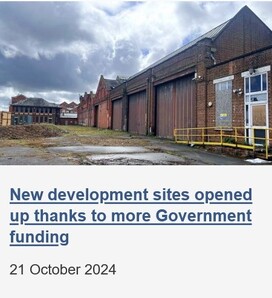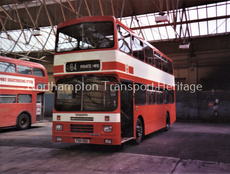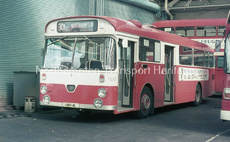
Inside the old Corporation Offices
Pictured left is what was part of the staircase in the Office Block, a lot of it now destroyed by vandals since the Depot was closed.
However it is not all bad news, we were delighted to assist in supplying photos and 1958 layout drawings to a company who are preparing a report on the restoring of the office block to its original state now it is a Listed Building.
It has been noted that the building is largely intact and retains many original features that all should be preserved in its restoration.
We will be receiving a copy of the report hopefully in the new year.
October 2025

Update Aug 2025
As you can see from this picture (courtesy of Arrun Day) the first part of the demolition has been completed. This area was already in a dangerous state with the roof ready to collapse, so there was an ideal demolition line of girders that can now be seen the length of the building left. We now await and see what any Developers want to do with the site, we have been promised the remaining facade will be left and the tram tracks utilised in some way on the site.
Northampton former tram shed and bus garage December 2024
Images from the videos of St James Bus and Tram Depot
Feel free to browse through my gallery images below.
October 2024 Update
This picture and announcement was placed on the West Northants web site today, 21st October 2024.


St James Bus Depot - Updated on 10th Sept 2024
Office Building at St James' Depot, St James' Road, Northampton - Awarded Listed Building Status
List Entry Number: 1489868
Following your application to add the above building to the List of Buildings of Special Architectural or Historic Interest, we have now considered all the representations made and completed our assessment of the building. I am delighted to inform you that having considered our recommendation, the Secretary of State for Culture, Media and Sport has decided to add Office Building at St James' Depot to the List of Buildings of Special Architectural or Historic Interest. The building is now listed at Grade II. Please note that the Tram Sheds and Garages at St James' Depot have not been granted Listing status.
We are now considering what to do next and await to see WNC's response. As the office building bis now a Listed Building, then anything done to the rest of the site will be scrutinised as it will now affect the setting of a Listed Building. The report also intimates that the whole site confirms to WNC's own Heritage Building Status rules that was approved in early 2024.
July 2024
So, it's been a few weeks since we had anything to report, due mainly to us having other things to be getting on with, and that there has not really been anything to report.
St James Tram and Bus Depot - Press Release 22 Jan 2024
The campaign in St James to save the historic Tram car sheds and bus depot took an important step last week, 17th January 2024, when Northampton Transport Heritage applied for the building to be designated as a listed building with Historic England by submitting a very detailed application. We have since received confirmation of the submission and we await further updates on its progress.
It has taken several months to pull items together, to craft the application which has led to some in depth research, and which has thrown up many interesting facts. Altogether, some 240 photographs and documents have been submitted as part of the application, some are very rare and have never been seen publicly before now.
In what would be an ironic step, NTH are calling for safeguards to be put in place and for WNC to serve on itself, a Building Preservation Notice (BPN), a little used tool in a council’s armoury that allows a six-months moratorium in order that the Historic England can work through the application to determine the historic status and therefore give the building protected status, until a determination is made. This process is little used, or known about, because of the fear of a compensation claim against the council by impatient developers. In this case, though, the developer and landowner is the local authority and it should not put itself at an advantage over any would be opposition merely because it is both the landowner, developer and planning authority, that is a potential conflict of interests and would be wholly inappropriate. Indeed, WNC cannot be all three things without some safeguards. Transparency is what is required now.
We were given an undertaking by the council leader four months ago that we would have a face-to-face meeting with himself, other respective council representatives and stakeholders, to try to reach an understanding and satisfactory outcome for all concerned, as well as a meaningful consultation with local people. Serving a Building Preservation Notice would be additional to those promises but would also underpin them and give time for all aspects of the case to be considered.
All six local area councillors have given their support to such meetings and the principle of preserving historic aspects of the site. We have yet to hear anything from the offices of the council leader or any department.
Graham Croucher, Chair of NTH and leading the Save the Depot campaign said; “We can still create a win, win situation here. The councils own document shows that it is uncertain as to what can be built on the site in terms of cost benefit ratios. Insider information tells us that affordable housing looks to be off the table due to this factor. Demolition and clean up costs have also yet to be factored into the total site expenditure. There is also concern, internally, that the purchase was not a shrewd move by the council.”
“So, whilst it evaluates and makes it mind up, we urge them not to rush into any hasty decisions, avoid a conflict of interests and not become that unscrupulous “developer” that rushes to demolish before a process can be determined. They need to allow the listing process to determine any historic value, for local people to have their say and to keep to their promises. We have now shown there is, and always has been, an historic value to this rare building and we are determined to protect it. We also call upon them to make the site safe and inaccessible to would be vandals and intruders, as already, in council ownership, fences are now falling over, leaving the site unsecure.”
Notes:
- St James Electric Tram depot was constructed in 1904 at St James on a site previously occupied by Stenson's Foundry (a name still acknowledged by the public house across the road called the "Foundrymans Arms" located on the corner of St James Road and Stenson St (formerly Foundry St) which was built before the depot in around 1890's.
- Northampton Corporation Tramways took over the horse drawn and private company Northampton Street Tramways Company in 1901, approving a replacement electric system in 1903.
- In its first year of operation a “profit” of £1500 was handed to the ratepayer, after all investments and costs were recouped, and the new system proved extremely beneficial to the whole town.
- The depot was constructed under the direction of Alfred Fidler, Borough Engineer with no assistance of any other outside architect. (See a more detailed history attached).
- Mr Fidler also drew up plans for local authority board schools and many other civic projects and other notable (and now listed) buildings/structures in Blackburn (Queens Park) and Southend (Marine Parade, Pier widening and railway, electric tram system and many other civic structures such as parks, sewer systems and civic buildings before being appointed in Northampton) .
- In Northampton, he designed the whole of the new tram system, to replace the horse drawn trams and Omnibuses, and within the budget of £85,000. Mr Fidler, oversaw, designed and implemented several civil projects within the Borough of Northampton as Borough Engineer. Including, but not limited to, the construction of the town’s new electric tramway system as well as overseeing the development of many of Northampton’s civil projects, even if in some case he was no the architect. These included;
- the development of the town’s Board Schools
- repairs to the Guildhall
- construction of the museum,
- Overseeing the design of the Carnegie public library
- the listed Technical College building in St George’s Avenue – “The plans of the college have been prepared by the committee’s architectural assistant, Mr Keightley Cobb L.R.I.B.A. under the supervision of Mr Alfred Fidler M. Inst. C.E.
- Many more civil projects such as road and sewerage schemes, and such as slum clearance and erection of civic buildings.
- As well as designing, or overseeing, many other projects such as Board schools and the Technical College in St Georges Avenue, which itself is a listed building he commissioned many important architects such as Matthew Holding. Indeed, he also designed the Corporation destructor plant, in Bath Street that burnt the towns rubbish and which also provided steam for his adjacent electricity generating plant that powered the towns tram system, both buildings were of a very similar design to the tram car sheds and shared the same external features, these though were later demolished.
- Julius Gottschalk was General Manager at the time of depot opening being transferred from the previous Northampton Street Tramways Company which was taken over by the Corporation in 1901. He was forced to resign at the start of the 1st WW because he had a German-sounding name despite spending many years serving Northampton in his capacity as General Manager of the Tramways.
- He was replaced by John F Cameron who joined the organisation in 1904 as electrical engineer working on the installation of the electrical equipment for the new tramway. He began his career in the tramway world in 1898 joining the staff of the famous Blackpool and Fleetwood Tramway, when tramway traction was in its infancy.
- As a youth, he gained experience in the locomotive shops of the Manx Northern Railway prior to joining the Blackpool and Fleetwood Tramway. His father being General Manager of this Railway, Cameron was also involved in the construction of the Laxey- Snaefell Mountain Railway in the Isle of Man. The Blackpool and Fleetwood, an early overhead trolley system, gave Cameron knowledge and experience.
- Cameron joined International Electrical Engineering Co. of Liege in Belgium, as Erection Engineer, employing him in charge of the erection of the Northampton contract, which covered the whole of the Power Station Plant for Northampton. He then was Assistant Electrical Engineer, for 4 years when in 1908 was appointed by the Council as Electrical Engineer, until 1914, becoming General Manager, holding both positions.
- Cameron developed the outfit into a successful, innovative organisation, including the ability to completely reconstruct its own tramcars in-house, was also instrumental in setting a legal precedent in 1925 of the important principle of how distance shall be measured from any given point, in acase brought about by the United Counties Omnibus Company. This case was reported at length in the Daily Press/Tramway Journals with the ruling that distance should be measured "as the crow flies" in a horizontal plane and the court found in the Corporation's (Cameron's) favour. He made Northampton famous for transport as it was for shoes. The depot was also used in WW2 for construction of fuselage sections for MK2 Lancaster Bombers.
- In 1905 land at the side of the depot was given over by the Tramways Committee for the erection of a new board (council) school following a lengthy campaign by non-conformists in St James (led by Rev. Jabez Bell, the Lewis family and many others, which resulted in long battle with the Church of England as to how religious instruction was to be taught to pupils. In the end over 200 pupils were locked out of lessons in St James and educated in Doddridge Memorial Chapel and the Central Hall in St James under the “Conscience Clause”. Such was the furore that in 1899 the subject was raised in the Houses of Parliament (and featured in Punch magazine nationally) and later the outcome of the St James problem would result in setting Education policy. The school was known as the “Tin School” because it was clad in corrugated iron and lasted until 1930 when it was replaced by the brand-new Spencer school, in Lewis Road, and to make way for further extension of the Bus garage. The school itself was later removed to Raeburn Road and re-erected there to serve as a board school, earning the nick name of the “Tin-Tac” school.
These are just brief, condensed anecdotes of the historic nature of the site and give short shrift to West Northamptonshire Council’s report that the building is of no historic value. Indeed, there is a wealth of history that has been uncovered, in addition to that already known.
January 2024 News
We have today (17 Jan 2024) submitted an application to Historic England to ask for listed status to the whole of the St James' Depot site. We will keep you updated on any further information.
We have added a great deal of photos and documents relating to the building and running of the tramway to our archives, and we are grateful to the National Tramway Museum at Crich for allowing us copies of what they hold - two of the pictures below - and also the research by our team to create a very comprehensive application we have submitted to Historic England. Below is the acknowedgement of receipt of our application.
Thank you for submitting your application ref: 1488047. This will now be considered by the Designation ApplicationsMidlands@HistoricEngland.org.uk Team, who will inform you about the progress of your application in due course.



Save The Depot Campaign
The St James Depot, the home of Northampton "Red" Buses and Trams from 1900's is now under threat and is now been purchased by West Northants Council for £3million (See November Update below), but the process for us continues to get the Council to consult with us and other parties on preserving as much of the buildings as possible and also take into consideration of the local people in St James.
If you want to help, offer assistance in our campaign, please contact us on savethedepot@ntheritage.org.
Below are a sample of photographs from our archives of the St James Bus Depot, some of the original tram lines are still visible.
With permission of Church's Shoes and the assistance of Northamptonshire Archives we have retrieved more data on vehicles/routes from the old Depot Offices and we will be sifting through the information over the coming months.
Thank You
November Update
Despite being advised had been sold to another company in September, it would appear that West Northants Council are currently purchasing the site for approx £3.3 - the headlines in the local newspaper says -





























